Insecticides Market Size
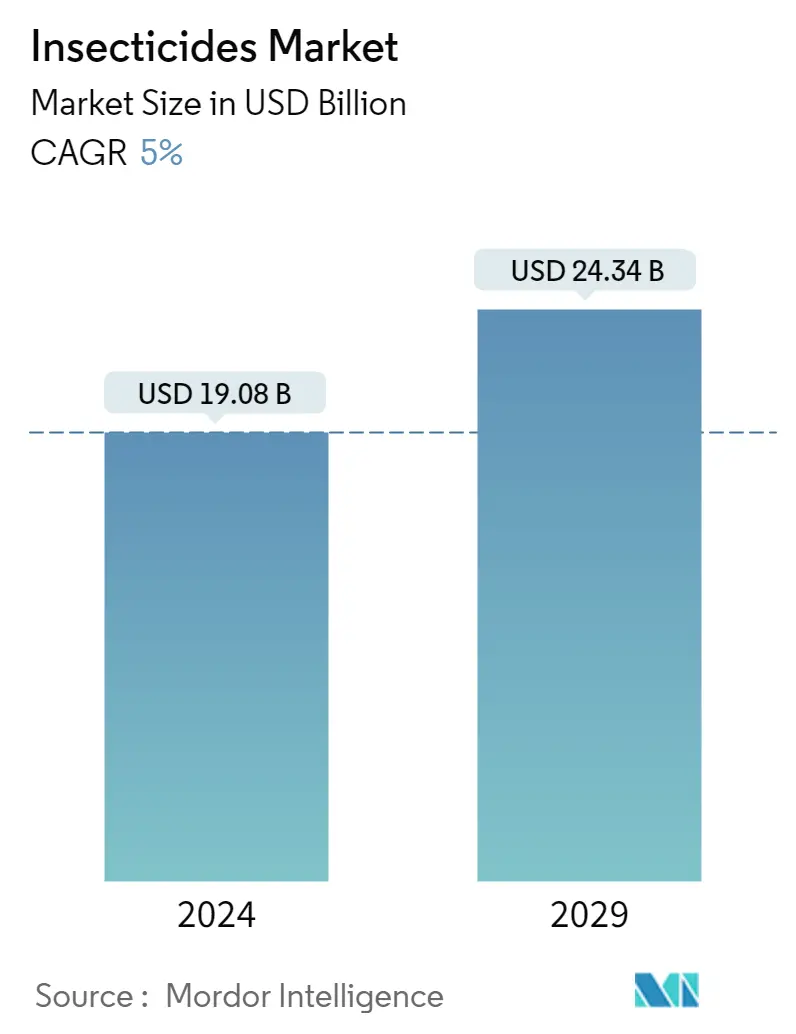
| Study Period | 2017-2027 |
| Market Size (2023) | USD 18.17 Billion |
| Market Size (2028) | USD 23.18 Billion |
| CAGR (2023 - 2028) | 5.00 % |
| Fastest Growing Market | Asia Pacific |
| Largest Market | Asia Pacific |
Major Players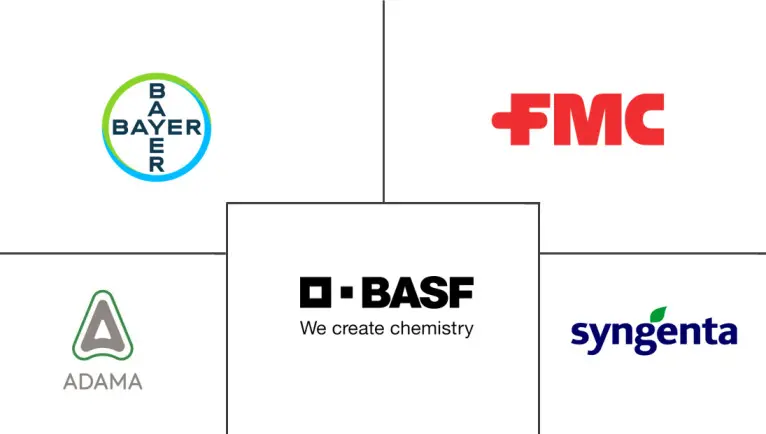
*Disclaimer: Major Players sorted in no particular order |
Need a report that reflects how COVID-19 has impacted this market and its growth?
Insecticides Market Analysis
The Insecticides Market size is expected to grow from USD 18 billion in 2023 to USD 23.18 billion by 2028, at a CAGR of 5% during the forecast period (2023-2028).
- The continuous rise in the population across the globe, increasing agricultural production to satisfy the rising food demand, and improvements in farming techniques and technologies are the factors that drive the market growth over the forecast period.
- The number of pests in different crops across the world is rising, and there is also a tremendous increase in the number of insecticide-resistant pests. Insecticides can be used to control a variety of pests. However, over time, they lose their effectiveness as pests develop resistance. This results in a significant decrease in sensitivity to a pesticide, which reduces the field performance of pesticides. Reliance on insecticide-based pest management of insect pests often leads to the development of insecticide resistance. This pushes the insecticide manufacturers to invest more in their R&D activities.
- The demand for professional pest management products is being driven by factors such as economic growth, urbanization, and the emergence of new pests and diseases. Consumers are increasingly looking for targeted and effective solutions with minimal environmental impact. Strict Regulations with respect to insecticides and high costs associated with molecule development may act as a barrier to the market in the coming years. However, given the profitability of the market, companies may still invest in insecticide development in the given period.
Insecticides Market Trends
This section covers the major market trends shaping the Insecticides Market according to our research experts:
Need for Increased Agricultural Productivity Amid Declining Farm Land
According to the FAO, global food demand is expected to increase from 50% to 90% by 2050, owing to the expected increase in the global population by over a third, or 2.3 billion people, between 2009 and 2050. Due to the increasing population globally, global food production needs are likely to increase by about 70% by 2050 to meet the growing food demand. This implies that there must be a significant increase in the production of certain food commodities. For instance, the production of cereals must reach around 3 billion metric ton by 2050, an increase from nearly 2.7 billion metric ton in 2021. The increased demand for food security has impacted the insecticide market affirmatively. This can be attributed to the high productivity of farms where appropriate usage of insecticides is practiced.
Many factors, from climate change to the outbreak of pests and lack of investment, have also restricted the production of food products. The percentage of arable land area is falling in major countries across the world, which indicates the need to enhance agricultural productivity to meet the population's rising demand. For instance, according to the World Bank data, the percentage of arable land kept on decreasing in the United Kingdom which is 25.1% in 2017 that decreased to 24.7% in 2020. Thus, farmers are focusing on increasing productivity by reducing the damage caused by pests. Hence, the market for crop protection chemicals is expected to grow around the world.
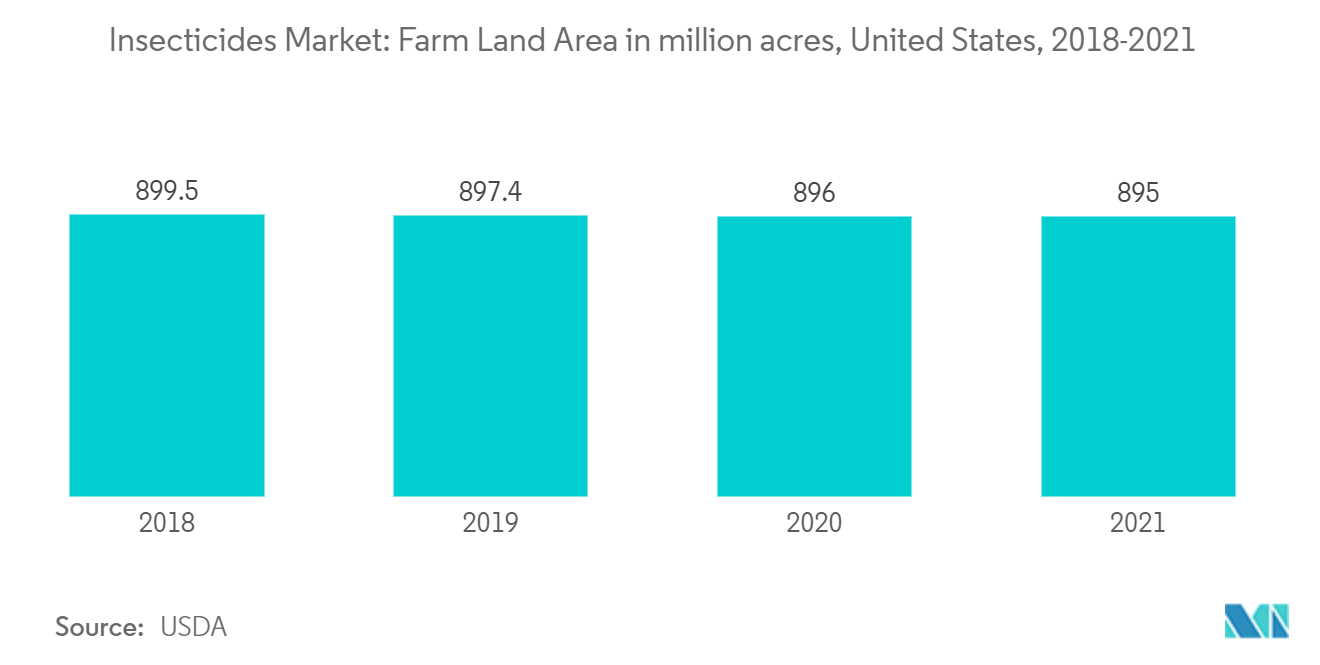
Asia-Pacific Dominates the Market
Asia Pacific region has varied climatic conditions which support the production of a wide variety of crops. The rise in the number of resistant pests, increasing food demand, and the need for increased agricultural productivity are the major factors driving the insecticide market in the Asia-Pacific region. China captures the largest share of the Asia-Pacific insecticides market. However, the use of conventional insecticides on agricultural crops in the country has declined in recent years, as the increased use of chemical insecticides, leading to environmental degradation, is causing severe soil pollution.
Farmers are anticipated to increase production by improving productivity through the use of pesticides to control the damage caused by pests. The lack of appropriate application of insecticides, along with adverse climatic conditions, will reduce the yield by 30.0%. With the rising awareness regarding the impact of chemical insecticides on the health of humans, the gradual shift toward the usage of eco-friendly, natural, and bioinsecticides by farmers has been observed in the region.
The region is also characterized by highly evolved technological advancements, which, in conjunction with increasing investments in R&D of biological insect control products, would serve the increasing domestic demand for quality food. The aforementioned factors can be attributed to the growth of the market in the region.
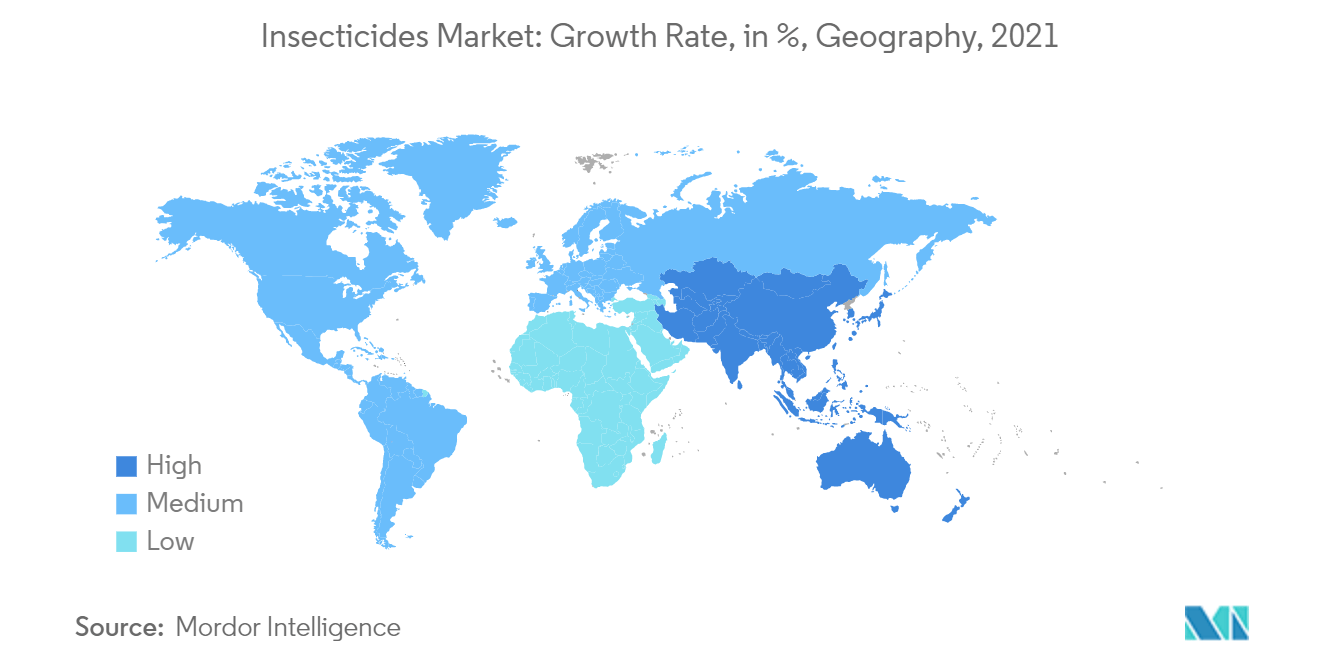
Insecticides Industry Overview
The insecticides market is consolidated, with key players holding the majority of the market share. Syngenta AG, Bayer Crop Science, FMC Corporation, ADAMA Agricultural Solutions Ltd, and BASF SE are the major players in the market studied. Players are likely to make efforts to make the market studied more consolidated in the future, as they have been expanding their business across the world by adopting various strategies, such as mergers and acquisitions, expansions, partnerships, and product launches.
Insecticides Market Leaders
Syngenta International AG
Bayer CropScience AG
BASF SE
FMC Corporation
ADAMA Agricultural Solutions Ltd
*Disclaimer: Major Players sorted in no particular order
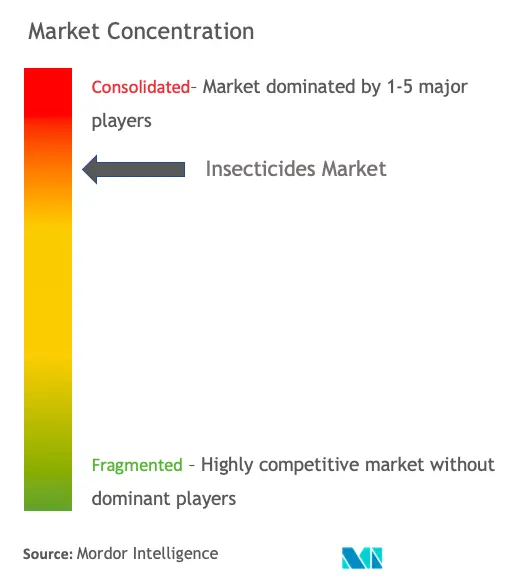
Insecticides Market News
April 2022: BASF SE launched Exponus insecticide in India which helps the farmers in the region to protect their crops from the pests like Caterpillars & Thrips and boosts crop productivity. It is registered to use on crops such as oilseeds, pulses, and vegetables.
February 2021: the Crop Science division at Bayer Vietnam launched Vayego 200SC, a new multi-insecticide and liquid formula containing tetraniliprole, an active ingredient discovered and developed by Bayer. The product works against caterpillars and addresses the diverse protection needs of modern farmers.
February 2021: Syngenta Crop Protection collaborated with an artificial intelligence (AI) company, Insilico Medicine, to increase the invention and development of new, more effective crop protection solutions that protect crops from diseases and pests.
Insecticides Market Report - Table of Contents
1. INTRODUCTION
1.1 Study Assumptions and Market Definition
1.2 Scope of the Study
2. RESEARCH METHODOLOGY
3. EXECUTIVE SUMMARY
4. MARKET DYNAMICS
4.1 Market Overview
4.2 Market Drivers
4.3 Market Restraints
4.4 Porter's Five Forces Analysis
4.4.1 Bargaining Power of Suppliers
4.4.2 Bargaining Power of Buyers
4.4.3 Threat of New Entrants
4.4.4 Threat from Substitute Products
4.4.5 Intensity of Competitive Rivalry
5. MARKET SEGMENTATION
5.1 Origin
5.1.1 Synthetic Insecticides
5.1.2 Bio-insecticides
5.2 Application
5.2.1 Grains and Cereals
5.2.2 Pulses and Oilseeds
5.2.3 Commercial Crops
5.2.4 Fruits and Vegetables
5.2.5 Turf and Ornmental
5.3 Insect Pest Type
5.3.1 Sucking Pest Insecticides
5.3.2 Biting and Chewing Pest Insecticides
5.4 Geography
5.4.1 North America
5.4.1.1 United States
5.4.1.2 Canada
5.4.1.3 Mexico
5.4.1.4 Rest of North America
5.4.2 Europe
5.4.2.1 Germany
5.4.2.2 United Kingdom
5.4.2.3 France
5.4.2.4 Spain
5.4.2.5 Italy
5.4.2.6 Russia
5.4.2.7 Rest of Europe
5.4.3 Asia-Pacific
5.4.3.1 China
5.4.3.2 Japan
5.4.3.3 India
5.4.3.4 Australia
5.4.3.5 Rest of Asia-Pacific
5.4.4 South America
5.4.4.1 Brazil
5.4.4.2 Argentina
5.4.4.3 Rest of South America
5.4.5 Middle East & Africa
5.4.5.1 South Africa
5.4.5.2 Rest of Africa
6. COMPETITIVE LANDSCAPE
6.1 Most Adopted Strategies
6.2 Market Share Analysis
6.3 Company Profiles
6.3.1 Adama Agricultural Solutions Ltd
6.3.2 American Vanguard Corporation
6.3.3 BASF SE
6.3.4 Bayer CropScience AG
6.3.5 Corteva Agriscience
6.3.6 FMC Corporation
6.3.7 Isagro SpA
6.3.8 NuFarm Limited
6.3.9 Syngenta AG
6.3.10 Adama Agricultural Solutions Ltd
6.3.11 Sumitomo Chemical Co. Ltd
6.3.12 UPL Limited
7. MARKET OPPORTUNITIES AND FUTURE TRENDS
Insecticides Industry Segmentation
All active ingredients that are used to control insect pests, including biological insecticides and antimicrobial insecticides, have been considered within the research scope. The study also includes insecticides applied by owners or operators and commercial applicators, to farms and facilities that are involved in the production of raw agricultural commodities, fiber, mainly food and tobacco.
The Insecticides Market is segmented by Origin (Synthetic Insecticides and Bio-insecticides), Application (Grains and Cereals, Pulses and Oilseeds, Commercial Crops, Fruits and Vegetables, and Turf and ornamental), Insect pest type (Sucking pest insecticides and Biting and chewing pest insecticides) and Geography (North America, Europe, Asia-Pacific, South America, and Middle-East and Africa). The report offers market size and forecasts in terms of value in USD million for all the above segments.
| Origin | |
| Synthetic Insecticides | |
| Bio-insecticides |
| Application | |
| Grains and Cereals | |
| Pulses and Oilseeds | |
| Commercial Crops | |
| Fruits and Vegetables | |
| Turf and Ornmental |
| Insect Pest Type | |
| Sucking Pest Insecticides | |
| Biting and Chewing Pest Insecticides |
| Geography | |||||||||
| |||||||||
| |||||||||
| |||||||||
| |||||||||
|
Insecticides Market Research FAQs
How big is the Insecticides Market?
The Insecticides Market size is expected to reach USD 18.17 billion in 2023 and grow at a CAGR of 5% to reach USD 23.18 billion by 2028.
What is the current Insecticides Market size?
In 2023, the Insecticides Market size is expected to reach USD 18.17 billion.
Who are the key players in Insecticides Market?
Syngenta International AG, Bayer CropScience AG, BASF SE, FMC Corporation and ADAMA Agricultural Solutions Ltd are the major companies operating in the Insecticides Market.
Which is the fastest growing region in Insecticides Market?
Asia Pacific is estimated to grow at the highest CAGR over the forecast period (2023-2027).
Which region has the biggest share in Insecticides Market?
In 2023, the Asia Pacific accounts for the largest market share in the Insecticides Market.
Insecticides Industry Report
Statistics for the 2023 Insecticides market share, size and revenue growth rate, created by Mordor Intelligence™ Industry Reports. Insecticides analysis includes a market forecast outlook to 2028 and historical overview. Get a sample of this industry analysis as a free report PDF download.
